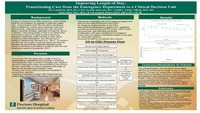Improving length of stay: Transitioning care from the emergency department to a clinical decision unit
View File(s)
- Author(s)
- Details
-
Griselle Pastor, DNP, MBA, RN, NE-BC; Justo Ruiz, Jr., MSN, RN, CEN; Van Cronkhite, BSN, RN, CEN; Natalie Mancuso, RN, CMSRN; Emilia Villoch, BSN, RN
- Sigma Affiliation
- Non-member
Visitor Statistics
Visits vs Downloads
Visitors - World Map
Top Visiting Countries
| Country | Visits |
|---|
Top Visiting Cities
| City | Visits |
|---|
Visits (last 6 months)
Downloads (last 6 months)
Popular Works for Pastor, Griselle by View
| Title | Page Views |
|---|
Popular Works for Pastor, Griselle by Download
| Title | Downloads |
|---|
View Citations
Citations
Session A presented Thursday, September 27, 10:00-11:00 am
Purpose: Emergency Departments (ED) experience overcrowding which can lead to unsafe and poor quality outcomes. Overcrowding in the ED can lead to decreased patient satisfaction, rushed and unpleasant treatment environments, distress for those who wait, and poor patient outcomes (Fogarty, Saunders & Cummins, 2013). For these reasons, it is imperative to improve ED throughput times. In addition, decreasing length of stay in an observation unit leads to reduced hospital acquired infections, decreased healthcare costs, increased patient satisfaction, and efficient use of inpatient hospital beds (Asudani & Tolia, 2013).
Design: Based on the throughput data analyzed by department leaders, a quality improvement project was undertaken.
Setting: At a not for profit community hospital, a transitional care process was implemented to improve ED throughput times as well as to decrease observation length of stay. Participants/Subjects: In collaboration, the emergency department (ED) and clinical decision unit (CDU) staff worked on a care delivery model in which patients who are identified as candidates for the CDU are expedited through the ED, quickly placed in observation status and then transferred to the CDU.
Methods: Pre and post data were collected using the electronic documentation system.
Results/Outcomes: This change in process resulted in an improvement of throughput from the time the bed is requested to the time the bed is occupied from an average of 2 hours and 4 minutes in October 2016 to an average of 1 hour and 32 minutes in October 2017. In addition, those patients that went to the CDU had consistently shorter observation lengths of stay, than patients that were transferred elsewhere in the hospital under observation status.
Implications: The Clinical Decision Unit has shown to be highly effective in decreasing the length of stay of observation patients. Through the collaboration between the ED and CDU teams we increased efficiency and decreased bed request to bed occupied times which subsequently decreases the length of stay of the patient in the ED. The transitional care process expedites the care of the patient being placed in observation status and accelerates the hand off report between nurses which in turn facilitates the patient transfer. In order to meet or exceed publicly reported national throughput benchmarks, leaders should consider instituting a transitional care process and having a short stay unit.
Emergency Nursing 2018. Held at David L. Lawrence Convention Center, Pittsburgh, Pennsylvania, USA
| Type | Poster |
| Acquisition | Proxy-submission |
| Review Type | Abstract Review Only: Reviewed by Event Host |
| Format | Text-based Document |
| Evidence Level | N/A |
| Research Approach | N/A |
| Keywords | Length of Stay; Clinical Decision Unit; Overcrowding in the ED |
| Name | Emergency Nursing 2018 |
| Host | Emergency Nurses Association |
| Location | Pittsburgh, Pennsylvania, USA |
| Date | 2018 |
All rights reserved by the author(s) and/or publisher(s) listed in this item record unless relinquished in whole or part by a rights notation or a Creative Commons License present in this item record.
All permission requests should be directed accordingly and not to the Sigma Repository.
All submitting authors or publishers have affirmed that when using material in their work where they do not own copyright, they have obtained permission of the copyright holder prior to submission and the rights holder has been acknowledged as necessary.
Related items
Showing items related by title, author, creator and subjects.
-
The role of fast tracks on length of stay in emergency departments
Watson, Brandon; Borkowski, Konrad; Conca-Petit, Jonathan (5/18/2017)Overcrowding in emergency departments (EDs) is a national crisis affecting hospitals. It has led to an association with poor patient outcomes and is a threat to public safety. Fast tracks (FTs) in the ED are one strategy ... -
Electronic handoff process for ED boarders admitted to medical-surgical and telemetry units
Medina, KatherineThe telephonic hand off process utilized to transfer ED boarders with assigned beds was causing major delays. The time from bed assignment to admission on the inpatient medical-surgical and telemetry units was 2 hours on ... -
Developing a culture of direct bedding in a freestanding ED
Novakovich, Elisabeth; Woodman, Judy; Woodman, Charles EdwardSession B presented Thursday, September 27, 11:30 am-12:30 pm Purpose: Emergency Department overcrowding is a serious problem that has a strong correlation with patient satisfaction.Wait times and overcrowding in Emergency ... -
Reducing low acuity length of stay a care paradigm transition
Wilson, Nicholas; Reed, Michelle (2017-12-05)Poster presentation, Session E presented Friday, September 15, 2017 Purpose: Emergency Department overcrowding is an epidemic in the United States. Use of services is often utilized by patients that do not require the ... -
A split-flow model for ED level 3 patients
Cabello, Brooke; Ruscio, Berta; Patel, Ami; Woodard, Tony; Tipton, Phyllis (2017-12-04)Purpose: Prolonged wait times and length of stays have inundated Emergency Departments(ED) across the nation. Our ED has struggled with these same hurdles over the past few years. Specifically, patients that are assigned ...





